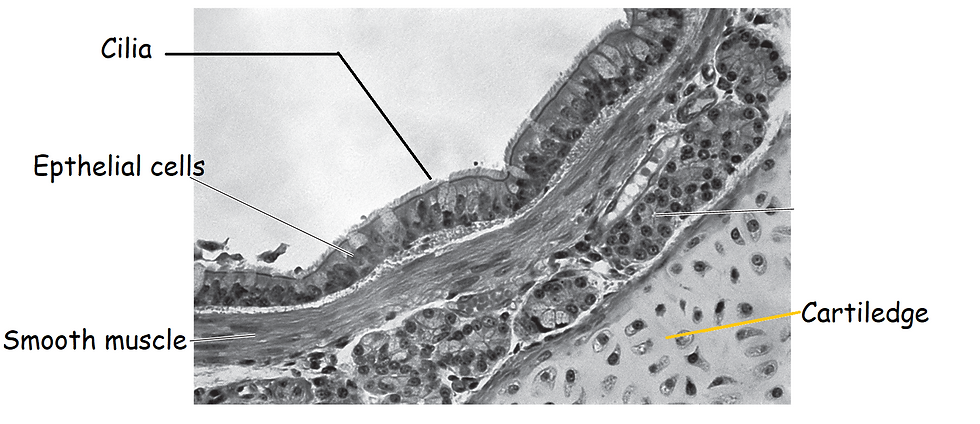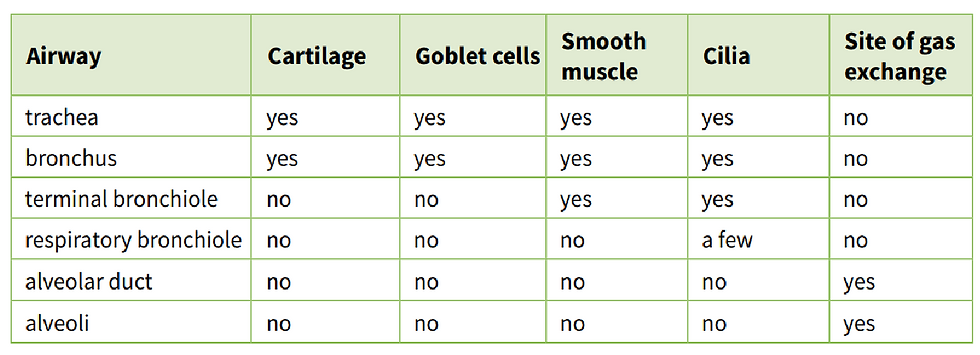
The human gas exchange system is responsible for exchanging oxygen and carbon dioxide between the body and the environment. The structure of this system includes the following components:
Lungs: The lungs are the primary organs of the respiratory system, located on either side of the chest. They are spongy and elastic, and they expand and contract during breathing to allow the exchange of gases.
Trachea: The trachea, also known as the windpipe, is a tube-like structure that connects the larynx (voice box) to the bronchi. It is lined with cilia, which help to prevent particles from entering the lungs.
Bronchi: The bronchi are two branches of the trachea that enter the lungs and further divide into smaller air passages called bronchioles.
Bronchioles: The bronchioles are the smallest air passages in the lungs, and they lead to clusters of tiny air sacs called alveoli.
Alveoli: The alveoli are tiny air sacs in the lungs where the exchange of gases between the air and the bloodstream takes place. They are surrounded by a network of capillaries, which allows the exchange of oxygen and carbon dioxide between the air and the bloodstream.
Capillary network: The capillary network is a network of tiny blood vessels that surrounds the alveoli. The walls of the capillaries are thin, allowing oxygen and carbon dioxide to diffuse easily between the bloodstream and the alveoli.
Transverse section of a Bronchus

Ciliated epithelial cells
The cilia on ciliated epithelial cells are involved in the removal of debris and mucus from the airways. The coordinated movement of the cilia helps to move mucus and debris toward the pharynx, where it can be expelled from the body. This helps to prevent the buildup of particles in the airways that could obstruct the flow of air and lead to infection.
Goblet cells
Goblet cells secrete mucus, which helps to moisturize and protect the airways. The mucus acts as a physical barrier, trapping particles and bacteria before they can reach the lungs. It also contains antibodies and other substances that help to neutralize harmful particles and prevent infections.

Mucous glands
Mucous glands are found in various parts of the respiratory system and secrete mucus to help keep the airways moist and free from debris. The secretion of mucus helps to prevent the airways from becoming dry and irritated, which can lead to coughing and other symptoms of respiratory distress.
Cartilage
Cartilage provides support to the airways, helping to keep them open and prevent them from collapsing during breathing. This allows air to flow freely into and out of the lungs, which is essential for efficient gas exchange.
Smooth muscle
The smooth muscle in the airways helps to regulate airflow and maintain proper ventilation of the lungs. It can constrict or relax in response to various stimuli, such as changes in the level of oxygen or carbon dioxide in the blood, or exposure to allergens or irritants. This helps to ensure that the lungs receive the appropriate amount of air and that the exchange of gases is efficient.
Elastic fibers
Elastic fibers are found in the walls of the airways and lungs, and they help to maintain their elasticity and shape. The elasticity of the lungs and airways allows them to expand and contract during breathing, which is essential for the exchange of gases.
Squamous epithelium
The squamous epithelium that lines the alveoli provides a large surface area for gas exchange to occur. The thin walls of the alveoli and the close proximity of the alveoli and capillaries allow oxygen and carbon dioxide to diffuse efficiently between the air and the bloodstream. This is essential for the efficient exchange of gases in the lungs.

Gas exchange
Oxygen from the air in the alveoli diffuses across the thin walls of the alveoli and into the capillaries, where it is picked up by the red blood cells.
The walls of the alveoli are only one cell layer thick, which allows for efficient diffusion of oxygen.
At the same time, carbon dioxide, a waste product produced by the body's cells, diffuses from the capillaries into the alveoli, where it is exhaled into the atmosphere.
The concentration of carbon dioxide in the blood is higher than in the air in the alveoli, which drives the diffusion of carbon dioxide from the blood into the alveoli.
The oxygen-rich blood from the capillaries then travels to the rest of the body through the circulatory system, where it is used to fuel cellular processes.
The carbon dioxide that has been exhaled from the lungs is replaced by fresh air inhaled into the alveoli, and the process of gas exchange continues.
Comments